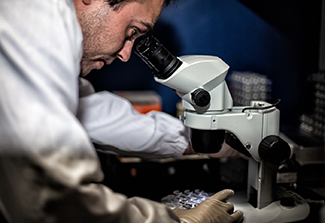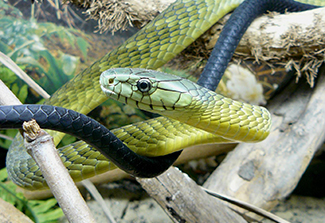Catapulting antivenom into the 21st Century
September / October 2022 | Volume 21 Number 5
 Courtesy of Constantinos Kurt Wibmer Constantinos Kurt Wibmer believes antivenom can be improved and made more accessible. His experience working on therapeutics for HIV informs his current work.
Courtesy of Constantinos Kurt Wibmer Constantinos Kurt Wibmer believes antivenom can be improved and made more accessible. His experience working on therapeutics for HIV informs his current work.
By Susan Scutti
In 2018 the World Health Organization proposed a strategy for reducing, by half, the mortality and disability caused by snakebites by the year 2030. Key to this plan is “ensuring safe, accessible and effective treatment.”
While an effective treatment—antivenom—currently exists, Constantinos Kurt Wibmer believes it can be improved and made more accessible. “Antivenom works but it has some of the same problems as all other medicines in low- and middle-income countries (LMICs): it's expensive and in short supply,” said the virologist and structural biologist at the University of the Witwatersrand’s Wits Health Consortium in South Africa. Add in the need to keep antivenom at low temperatures and the possibility of extreme side effects due to impurities and “safe, accessible, and effective” looks less achievable
“If we had a modern drug, we would be able to get around these issues. For example, we can make something that's temperature stable. We can make something that's pure, so you can avoid anaphylactic shock. We might even be able to make compounds that can be given in the field instead of rushing someone to a hospital to give antivenom by IV,” said Wibmer.
Reducing death and disability caused by snakebite
Scientists believe five million snakebites occur each year, yet this number is likely inaccurate due to underreporting. Roughly half a million annual bites are serious leading to between 100,000 and 150,000 deaths. The remaining 400,000 people will lose an arm, a foot, or maybe an eye, said Wibmer: “So that's a livelihood gone—if you can no longer work in the field or you can’t walk because your foot has been amputated. And that will affect the whole family and possibly an entire community.”
Hundreds of snakes are responsible for bites with up to 200 that can “really do damage,” said Wibmer. Each snake acts on its prey in a different way so different venoms have unique components; this also means patients must correctly identify a snake to receive the correct antivenom. For example, the venom of certain vipers or adders common to South and Central Americas and Central Africa affects how blood clots, so a bite can cause bleeding from the eyes; other venoms can spur a blood clot leading to a heart attack or an embolism. “Then the neurotoxic snakes, like cobras and mambas, can shoot venom into your eyes, where it goes straight to the nervous system, slowing down breathing and heart rate.”
Years of experience in virology showed Wibmer how antivenom can be transformed. “While I was working on HIV at Scripps, I was introduced to the challenges with current antivenom. A colleague approached me to discuss the topic, and we realized that many of the same things that we were doing in HIV would apply to snakebite.” Next-generation antivenoms need to be “high-affinity products that are long-lasting in the body, which is what we engineer into current therapeutics for other diseases,” he said.
Wibmer is pursuing two different approaches to achieve these goals. “One is the antibody isolation approach—trying to get antibodies from immunized animals and then making them in a lab, so that they can be 100% pure, engineered to stay in the body for a month, and effective in a small enough dose to be given in the field,” he said. A second approach is based on structural biology methodologies: Identify proteins that resemble the targets of venom (such as blood clotting cascades) and then enhance them through engineering. “So, take these proteins, look at their structures and make changes that would make them more stable, more broadly reactive (across various snake species) and more potent in their interaction, so they would out-compete the venom binding in your body.”
 This black tailed mamba, found in central Africa, is considered one of the most dangerous of snakes with its neurotoxic venom
This black tailed mamba, found in central Africa, is considered one of the most dangerous of snakes with its neurotoxic venom
Wibmer uses both approaches in his efforts to synthesize a broadly reactive therapeutic for various snake species native to both Africa and Asia. He has expressed snake toxins from each of the major toxin classes and characterized them using x-ray protein crystallography. The next step in his project is to use structure-guided protein design to improve the binding regions of his lead protein candidates. So far, he’s built “a solid foundation” for continued work, despite disruptions caused by SARS-CoV-2. “Africa has huge shipping issues, which the pandemic exacerbated. I am now receiving things that I ordered in 2020!”
Wibmer remains hopeful of a good result because venom is unlike his former research focus, HIV, which is a “moving target” that evolves in millions of people every year. “Snakes evolved venom for their prey—they do not care about humans—so it’s the same toxin honed for the same rodents and birds. Even though venoms are diverse, it is easier to design interventions for them, because they’re a stable target.” Still, he does not underestimate the challenges he faces, such as disseminating new medicines to LMICs and getting interest from Western pharmaceutical companies or investment for local drug development and manufacturing.
“A lot of people in LMICs don't think highly of their own science. They think science is not important unless it comes from one of the big Western countries. When you look at the big labs doing work in India, in Africa, in Brazil, the people are comparable but getting them to believe that they are just as good as ‘big name so and so’ presenting at the conference—this is something we need to address. Because that confidence helps drive the passion and inspires people to produce good science.”
More Information
Updated October 6, 2022
To view Adobe PDF files,
download current, free accessible plug-ins from Adobe's website.
Related Fogarty Programs
Related World Regions / Countries
Related Global Health Research Topics